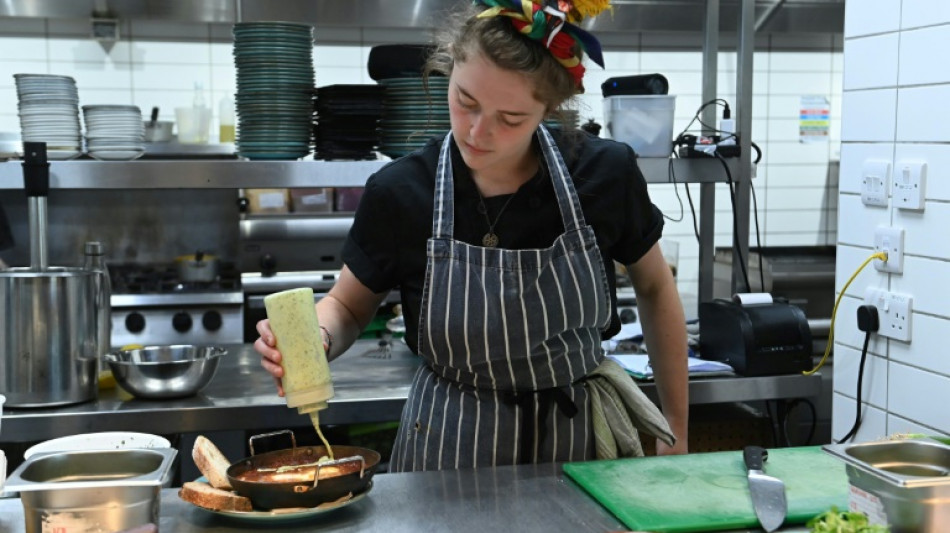
-
 Boeing strike will hurt Ethiopian Airlines growth: CEO
Boeing strike will hurt Ethiopian Airlines growth: CEO
-
Springboks skipper Kolisi wary of England's 'gifted' Smith

-
 End of a love affair: news media quit X over 'disinformation'
End of a love affair: news media quit X over 'disinformation'
-
US finalizes up to $6.6 bn funding for chip giant TSMC

-
 Scholz urges Ukraine talks in first call with Putin since 2022
Scholz urges Ukraine talks in first call with Putin since 2022
-
Zverev reaches ATP Finals last four, Alcaraz on brink of exit

-
 Lebanon rescuer picks up 'pieces' of father after Israel strike
Lebanon rescuer picks up 'pieces' of father after Israel strike
-
US retail sales lose steam in October after hurricanes

-
 Zverev reaches ATP Finals last four with set win against Alcaraz
Zverev reaches ATP Finals last four with set win against Alcaraz
-
Kerevi back for Australia against Wales, Suaalii on bench

-
 Spate of child poisoning deaths sparks S.Africa xenophobia
Spate of child poisoning deaths sparks S.Africa xenophobia
-
Comedian Conan O'Brien to host Oscars

-
 Rozner overtakes McIlroy and Hatton for Dubai lead
Rozner overtakes McIlroy and Hatton for Dubai lead
-
Mourners bid farewell to medic killed in east Ukraine

-
 Gore says 'absurd' to hold UN climate talks in petrostates
Gore says 'absurd' to hold UN climate talks in petrostates
-
Hamas says 'ready for ceasefire' as Israel presses Gaza campaign

-
 Amorim says Man Utd is 'where I'm supposed to be'
Amorim says Man Utd is 'where I'm supposed to be'
-
Japan hammer Indonesia to edge closer to World Cup spot

-
 Jeff Beck guitar collection to go under the hammer in January
Jeff Beck guitar collection to go under the hammer in January
-
Veteran Ranieri has 'no time for mistakes' on Roma return

-
 Van Nistelrooy says he will 'cherish' Man Utd memories in farewell message
Van Nistelrooy says he will 'cherish' Man Utd memories in farewell message
-
IAEA chief tours sensitive Iran nuclear plants

-
 Pompeii rejects 'mass tourism' with daily visitor limit
Pompeii rejects 'mass tourism' with daily visitor limit
-
Jailed Russian poet could be 'killed' in prison, warns wife

-
 French court orders release of Lebanese militant held since 1984
French court orders release of Lebanese militant held since 1984
-
Global stocks struggle after Fed signals slower rate cuts

-
 UK economy slows, hitting government growth plans
UK economy slows, hitting government growth plans
-
Primary schools empty as smog persists in Indian capital

-
 Palestinians turn to local soda in boycott of Israel-linked goods
Palestinians turn to local soda in boycott of Israel-linked goods
-
Typhoon Man-yi bears down on Philippines still reeling from Usagi

-
 UK growth slows in third quarter, dealing blow to Labour government
UK growth slows in third quarter, dealing blow to Labour government
-
Chris Wood hits quickfire double in NZ World Cup qualifying romp

-
 Markets struggle at end of tough week
Markets struggle at end of tough week
-
China tests building Moon base with lunar soil bricks

-
 Film's 'search for Palestine' takes centre stage at Cairo festival
Film's 'search for Palestine' takes centre stage at Cairo festival
-
Oil execs work COP29 as NGOs slam lobbyist presence

-
 Gore says climate progress 'won't slow much' because of Trump
Gore says climate progress 'won't slow much' because of Trump
-
'Megaquake' warning hits Japan's growth

-
 Stiff business: Berlin startup will freeze your corpse for monthly fee
Stiff business: Berlin startup will freeze your corpse for monthly fee
-
Wars, looming Trump reign set to dominate G20 summit

-
 Xi, Biden attend Asia-Pacific summit, prepare to meet
Xi, Biden attend Asia-Pacific summit, prepare to meet
-
Kyrgios to make competitive return at Brisbane next month after injuries

-
 Dominican Juan Luis Guerra triumphs at 25th annual Latin Grammys
Dominican Juan Luis Guerra triumphs at 25th annual Latin Grammys
-
Landslide win for Sri Lanka president's leftist coalition in snap polls

-
 Australian World Cup penalty hero Vine takes mental health break
Australian World Cup penalty hero Vine takes mental health break
-
As Philippines picks up from Usagi, a fresh storm bears down

-
 Tropical Storm Sara pounds Honduras with heavy rain
Tropical Storm Sara pounds Honduras with heavy rain
-
Pepi gives Pochettino win for USA in Jamaica

-
 'Hell to heaven' as China reignite World Cup hopes with late winner
'Hell to heaven' as China reignite World Cup hopes with late winner
-
Rebel attacks keep Indian-run Kashmir on the boil

| CMSC | 0.41% | 24.65 | $ | |
| BTI | 2.38% | 36.355 | $ | |
| BP | -0.28% | 28.97 | $ | |
| BCC | -0.38% | 139.815 | $ | |
| SCS | 0.38% | 13.32 | $ | |
| NGG | 0.35% | 62.59 | $ | |
| GSK | -1.83% | 33.3899 | $ | |
| BCE | -0.98% | 26.58 | $ | |
| RIO | 0.8% | 60.92 | $ | |
| CMSD | -0.07% | 24.34 | $ | |
| RBGPF | 2.67% | 61.84 | $ | |
| JRI | -0.3% | 13.0368 | $ | |
| RYCEF | 0.88% | 6.85 | $ | |
| RELX | -3.04% | 44.595 | $ | |
| VOD | 0.97% | 8.765 | $ | |
| AZN | -2.46% | 63.48 | $ |

On the menu at a UK restaurant: carbon footprint
The menu at The Canteen in southwest England doesn't just let diners know how much a dish costs. They can also check its carbon footprint.
The carrot and beetroot pakora with yoghurt sauce is responsible for just 16 grams of CO2 emissions. The aubergines with a miso and harissa sauce with tabbouleh and Zaatar toast caused 675 grams of carbon dioxide.
As customers weigh their options, the menu at the vegetarian restaurant in Bristol includes a comparison with a dish that it does not serve: the emissions from a UK-produced hamburger.
"Three kilos for a burger, wow! I can't believe it," exclaimed Enyioma Anomelechi, a 37-year-old diner sipping a beer outside in the sunshine.
The menu notes that a real beef burger's emissions is "10 times the amount of its vegan alternative".
The carbon footprints of businesses and consumers have come under growing scrutiny as countries scramble to limit global temperature increases to 1.5 degrees Celsius and to achieve net-zero emission by 2050.
The Canteen became in July the first restaurant to agree to put its carbon footprint on the menu under a campaign spearheaded by UK vegan campaigning charity Viva!
The restaurant's manager, Liam Stock, called the move a way to "see what we are doing; to understand and improve ourselves".
The average British person has an annual carbon footprint of more than 10 tonnes, according to UK government figures.
Britain has set the ambitious goal of reducing harmful emissions by 78 percent by 2035, compared with 1990 figures, in order to meet its international climate change commitments.
- 'Climate emergency' -
Switching to a plant-based diet is one of the most effective ways for an individual to reduce their carbon footprint, experts from the UN's Intergovernmental Panel on Climate Change said in April.
The livestock industry replaces CO2-absorbing forests with land for grazing and soy crops for cattle feed. The animals also belch huge amounts of methane, a potent greenhouse gas.
Whether diners will let carbon footprints influence their order choices remains to be seen, but Stock said the menu innovation has stoked interest and support.
"In England if you're a big chain restaurant, it's the law that you have to have calories on (the menu)," he said.
"But a lot of people are saying... they're more interested in carbon."
While Anomelechi noted the "huge" difference in emissions between a hamburger and other dishes, he said he did not necessarily want to be burdened with knowing his order's calorie count or carbon footprint.
"When I go out to eat I just want to enjoy," he added, noting he would be more inclined to change his ways when grocery shopping.
Laura Hellwig, campaigns manager at Viva!, said the carbon footprint figure should become compulsory.
"We are in a climate emergency and consumers have to be able to make informed choices," said the activist.
In her view, "most people would actually choose for the planet" if confronted with a comparison between the carbon footprint of a meat-based meal and a vegan dish.
- 'Cradle to store' -
Stock said he knew his restaurant's dishes would score low carbon footprints, as most of his ingredients are sourced regionally.
"We didn't have to change anything," he said, while admitting some surprises, such as learning that imported spices drive up emissions.
To calculate the dishes' footprints, The Canteen sent its recipes and the source of the ingredients to a specialised company called MyEmissions.
It is able to calculate the carbon impact from "cradle to store", taking into account farming, processing, transport and packaging.
"If I was choosing between two dishes, maybe depending on how hungry I was, I might choose the one with a lower footprint," said Nathan Johnson, a 43-year-old diner at the restaurant.
That day, he opted for the chef's salad, which racks up 162 grams of carbon.
Another diner, 29-year-old Emma Harvey, also backed the idea of increased awareness of carbon footprints "and the ethical effects of the food that we're eating".
"We have to incorporate things (like) that into everyday life," she said.
A.Taylor--AT



